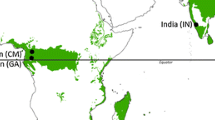Summary
A few assumptions were used to generate a series of specific, quantitative predictions for the relationships between stand density and various dimensional measures of canopy structure. The predictions, each indicating an increase in mean crown size as density decreased, appeared to be reasonable and intuitive. Predictions were compared to data for two conifer species with different crown forms, Pinus contorta var. latifolia and Abies lasiocarpa. Results of these comparisons were mixed — the linear, directly measured dimensions were consistent with predicted relationships, but dimensions calculated from the linear measures were not. Re-examination of the original assumptions indicated that the model should account for crown shyness (engagement/disengagement) to adequately reflect the influence of stand density on canopy structure. The results also indicated a strong association between stand height and measures of mean crown size. Mean crown size of lodgepole pine was altered much more by density than was mean crown size of subalpine fir, due primarily to the different relative shade tolerances of the two species. Some of the observed differences between species may also reflect the range of densities examined and uneven spacing in the unmanaged natural stands.
Similar content being viewed by others
References
Assmann E (1970) The principles of forest yield study. Pergamon, Oxford
Beekhuis J (1965) Crown depth of radiata pine in relation to stand density and height, NZ J For 10: 43–61
Caldwell MM (1987) Plant architecture and resource competition. In: Schulze E-D, Zwölfer H (eds) Potentials and limitations of ecosystem analysis. Springer, Berlin Heidelberg New York, pp 164–179
Curtis RO, Reukema DL (1970) Crown development and site estimates in a Douglas-fir plantation spacing test. For Sci 16: 287–301
Czarnowski MS (1961) Dynamics of even-aged forest stands. La State Univ Stud Biol Sci Ser 4
Elfron B, Tibshirani R (1986) Bootstrap methods for standard errors, confidence intervals, and other measures of statistical accuracy. Stat Sci 1: 54–77
Fowells HA, ed (1965) Silvics of forest trees of the United States. USDA For Serv Agric Handbook No 271
Franco M (1986) The influence of neighbours on the growth of modular organisms with an example from trees. Philos Trans R Soc London Ser B 313: 209–225
Hamilton GJ (1969) The dependence of volume increment of individual trees on dominance, crown dimensions, and competition. Forestry 49: 133–144
Hart GE, Lomas DA (1979) Effects of clearcutting on soil water depletion in an Engelmann spruce stand. Water Resour Res 15: 1598–1602
Kajihara M (1977) Studies on the morphology and dimensions of tree crowns in even-aged stand of Sugi (V): crown surface area and crown volume. J Jpn For Soc 59: 233–240
Kanazawa Y, Kiyono Y, Fujimori T (1985) Crown development and stem growth in relation to stand density in even-aged stands (II) Clear-length model of Cryptomeria japonica stands as a function of stand density and tree height. J Jpn For Soc 67: 391–397
Kellomäki S, Kuuluvainen T, Kurttio O (1986) Effect of crown shape, crown structure and stand density on the light absorption in a tree stand. In: Fujimori T, Whitehead D (eds) Crown and canopy structure in relation to primary productivity. Forestry and Forestry Products Research Institute, Ibaraki, Japan, pp 339–359
Krajicek JE, Brinkman KA, Gringrich SF (1961) Crown competition —measure of density. For Sci 7: 35–42
Laduc DJ (1987) A comparative analysis of the reduced major axis technique for fitting lines to bivariate data. Can J For Res 17: 654–659
Long JN (1985) A practical approach to density management. For Chron 61: 23–27
Long JN, Smith FW (1984) Relation between size and density in developing stands: a description and possible mechanisms. For Ecol Manage 7: 191–206
Long JN, Smith FW (1989) Estimating leaf area of Abies lasiocarpa across ranges of stand density and site quality. Can J For Res 19: 930–932
Mohler CL, Marks PL, Sprugel DG (1978) Stand structure and allometry of trees during self-thinning of pure stands. J Ecol 66: 599–614
Norberg R (1988) Theory of growth geometry of plants and self-thinning of plant populations: geometric similarity, elastic similarity, and different growth modes of plant parts. Am Nat 131: 220–256
Putz FE, Parker GG, Archibald RM (1984) Mechanical abrasion and intercrown spacing. Am Midl Nat 112: 24–28
Reineke LH (1933) Perfecting a stand-density index for even-aged forests. J Agric Res 46: 627–638
Richards NA, Morrow RR, Stone EL (1962) Influence of soil and site on red pine plantations in New York. Cornell Univ Agric Expt Sta Bull 977
SAS Institute Inc (1987) SAS/STAT guide for personal computers, version 6 edition. SAS Insitute Inc, Cary, NC
Schimpf DJ, Henderson JA, MacMahon J (1980) Some aspects of succession in the spruce-fir forest zone of northern Utah. Great Basin Nat 40: 1–26
Seim E, Saether B-E (1983) On rethinking allometry: which regression model to use? J Theor Biol 104: 161–168
Seymour RS, Smith DM (1987) A new stocking guide formulation applied to eastern white pine. For Sci 33: 469–484
Stiell WM (1966) Red pine crown development in relation to spacing. Can Dept For Publ No 1145
White J (1981) The allometric interpretation of the self-thinning rule. J Theor Biol 89: 475–500
Wilson FG (1946) Numerical expression of stocking in terms of height. J For 44: 758–761
Zeide B (1987) Analysis of the 3/2 power law of self-thinning. For Sci 33: 517–537
Author information
Authors and Affiliations
Rights and permissions
About this article
Cite this article
Jack, S.B., Long, J.N. Analysis of stand density effects on canopy structure: a conceptual approach. Trees 5, 44–49 (1991). https://doi.org/10.1007/BF00225334
Received:
Accepted:
Issue Date:
DOI: https://doi.org/10.1007/BF00225334




